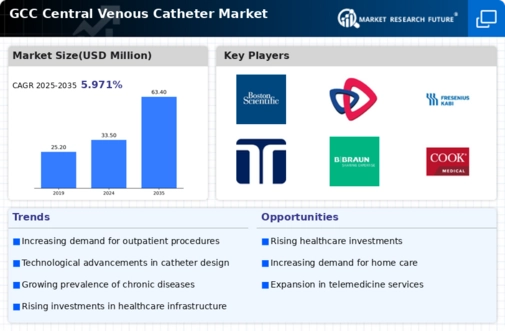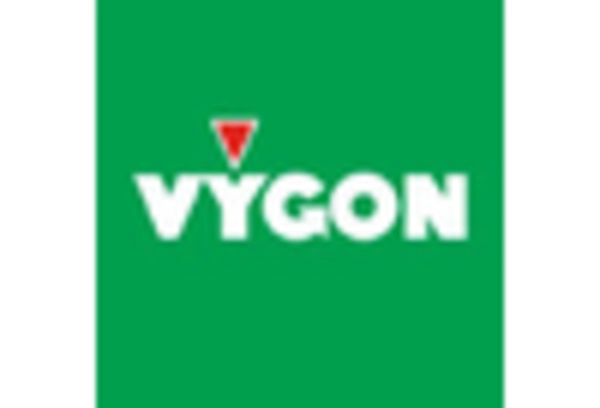Increasing Healthcare Expenditure
The central venous-catheter market is likely to benefit from the rising healthcare expenditure across the GCC region. Governments are investing heavily in healthcare infrastructure, which is projected to grow at a CAGR of approximately 7% from 2025 to 2030. This increase in funding is expected to enhance the availability of advanced medical devices, including central venous catheters, in hospitals and clinics. As healthcare facilities expand and modernize, the demand for effective and reliable vascular access solutions is anticipated to rise. Furthermore, the growing emphasis on improving patient outcomes and reducing hospital stay durations may drive the adoption of central venous catheters, thereby positively impacting the market. The overall growth in healthcare spending is a crucial driver for the central venous-catheter market, as it facilitates the procurement of innovative medical technologies.
Rising Number of Surgical Procedures
The central venous-catheter market is experiencing growth due to the increasing number of surgical procedures performed in the GCC region. With advancements in surgical techniques and an expanding range of minimally invasive procedures, the demand for effective vascular access solutions is on the rise. It is estimated that the number of surgeries in the region could increase by 5-6% annually, leading to a higher requirement for central venous catheters. These devices are essential for administering medications, fluids, and nutrition during surgeries, making them indispensable in operating rooms. As surgical volumes continue to rise, the central venous-catheter market is expected to expand, driven by the need for reliable and efficient vascular access during complex medical interventions.
Growing Awareness of Infection Control
The central venous-catheter market is likely to be influenced by the increasing awareness of infection control practices among healthcare providers in the GCC. The rise in hospital-acquired infections (HAIs) has prompted healthcare facilities to adopt stringent infection prevention protocols. This trend is reflected in the growing demand for advanced catheter designs that minimize the risk of infections, such as antimicrobial-coated catheters. The market for these specialized devices is projected to grow by approximately 8% annually as hospitals prioritize patient safety and quality of care. Enhanced training for healthcare professionals regarding the proper use and maintenance of central venous catheters is also contributing to this trend. Consequently, the focus on infection control is a significant driver for the central venous-catheter market, as it encourages the adoption of safer and more effective vascular access solutions.
Technological Innovations in Catheter Design
The central venous-catheter market is poised for growth due to ongoing technological innovations in catheter design and materials. Manufacturers are increasingly focusing on developing catheters that offer enhanced functionality, such as improved biocompatibility and reduced thrombogenicity. Innovations like ultrasound-guided catheter placement and smart catheters equipped with sensors are gaining traction in the GCC region. These advancements not only improve patient outcomes but also streamline the insertion process, reducing complications associated with traditional methods. The market for technologically advanced central venous catheters is expected to expand significantly, as healthcare providers seek to adopt the latest innovations to enhance patient care. This focus on technological progress is a key driver for the central venous-catheter market, as it aligns with the broader trend of integrating advanced technologies into healthcare.
Aging Population and Increased Healthcare Needs
The central venous-catheter market is likely to be driven by the aging population in the GCC, which is leading to increased healthcare needs. As the demographic landscape shifts, the prevalence of age-related health conditions is expected to rise, necessitating more frequent medical interventions. It is projected that the population aged 65 and older in the GCC will increase by over 20% by 2030, resulting in a higher demand for effective vascular access solutions. Central venous catheters play a crucial role in managing chronic diseases and facilitating long-term treatments, making them essential in geriatric care. This demographic trend is a significant driver for the central venous-catheter market, as healthcare systems adapt to meet the growing needs of an aging population.

















Leave a Comment